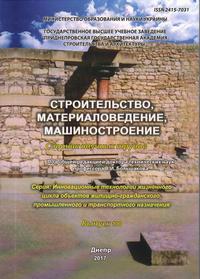Local heat fluxes statistics in two-dimensional models of two-phase composite materials
Keywords:
composite material, Monte Carlo method, local heat fluxes, statistical analysis, dynamics of distribution parametersAbstract
Abstract. Purpose. The goal of this work is to test the statistical hypothesis on the polymodal distribution peaks character of the of the local heat fluxes intensities in two-phase composite material. Another object is to perform a statistical analysis of the matrix and inclusions parameters influence on the characteristics of this distribution. Methodology. We modeled the steady-state distribution of the thermophysical characteristics of a quasi-two-dimensional two-phase composite with randomly placed inclusions by the Monte Carlo method. The internal Dirichlet problem for a homogeneous stationary heat equation with first kind boundary conditions was solved numerically by the method of the top progressive relaxation. We used the procedure of statistical identification of polymodal distributions of local heat fluxes. Results. Numerical calculations were carried out and scenarios for local heat fluxes were considered when the parameters of both the inclusions and their placement in the matrix are changed. Assuming the lognormal distribution law we separated the polymodal distribution of local heat fluxes into three modes. The influence of the matrix and inclusions parameters on the individual modes dynamics was studied. Comparing heat fluxes charts and histograms of the distribution of heat fluxes intensities, we defined the areas of the composite matrix which corresponded to each mode. Originality. The areas of the quasi-two-dimensional composite which correspond the local heat fluxes with the distribution of three different types were statistically confirmed and spatially localized for the first time. The analysis of the factors which affect the main characteristics of these distributions was carried out. Practical value. The results of a numerical study of the local heat fluxes distribution can be used both for predicting the results of thermal exploitation of available two-phase composites and for simulating the new composite materials thermophysical characteristics.References
Vanin G.A. Mikromehanika kompozicionnyh materialov [Micromechanics of composite materials]. Kyiv: Naukova dumka, 1985, 305 p. (in Russian).
Zaginajlo I.V., Maksimenjuk Ja.A. and Pisarenko A.N. Rol' inducirovannyh teploprovodjashhih kanalov v formirovanii teploizolirujushhih svojstv dvuhkomponentnyh kompozicionnyh materialov [The role of induced heat-conducting channels in the formation of heat-insulating properties of two-component composite materials]. Stroitel'stvo, materialovedenie, mashinostroenie
[Construction, materials science, mechanical engineering]. PDABA. Dnipropetrovsk, 2016, no. 92, pp. 56-61.
Chen Y.-M. and Ting J.-M. Ultra high thermal conductivity polymer composites. Carbon. 2002, vol. 40, pp. 359-362.
Fiedler, T., Öchsner, A., Muthubandara, N., Belova, I.V. and Murch, G.E. Calculation of the Effective Thermal Conductivity in Composites Using Finite Element and Monte Carlo Methods. Materials Science Forum. 2007, vol. 553, pp. 51-56.
Gori F. and Corasaniti S. Effective thermal conductivity of composites. International Journal of Heat and Mass Transfer. 2014, vol. 77, pp. 653-661.
Graham S. and McDowell D. Numerical analysis of the transverse thermal conductivity of composites with imperfect interfaces. Journal of Heat Transfer. 2003, vol. 125, pp. 389-393.
Gusev A.A. Representative volume element size for elastic composites: a numerical study. Journal of Mechanics and Physics of Solids. 1997, vol. 45, pp. 1449-1459.
Hui P.M., Zhang X., Markworth A.J. and Stroud D. Thermal conductivity of graded composites: Numerical simulations and an effective medium approximation. Journal of Materials Science. 1999, vol. 34, pp. 5497-5503.
James B.W. and Harrison P. Analysis of the temperature distribution, heat flow and effective thermal conductivity of homogeneous composite materials with anisotropic thermal conductivity. Journal of Physics D.: Applied Physics. 1992, vol. 25, no. 9, pp. 1298-1303.
Kanit T., Forest S., Galliet I., Mounoury V. and Jeulin D. Determination of the size of the representative volume element for random composites: statistical and numerical approach. International Journal of Solids and Structures. 2003, vol. 40, pp. 36473679.
Zaginaylo I.V., Maksimeniuk Ya.A. and Pysarenko A.N. Two-dimensional numerical simulation study of the effective thermal conductivity statistics for binary composite materials. International Journal of Heat and Technology. 2017, vol. 35, no. 2, pp. 364-370.
Zarubin V.S. and Kuvyrkin G.N. Two-sided estimates for thermal resistance of an inhomogeneous solid body. High Temperature. 2013, vol. 51, no. 4, pp. 519-525.
Downloads
Published
Issue
Section
License
Редакція Видання категорично засуджує прояви плагіату в статтях та вживає всіх можливих заходів для його недопущення. Плагіат розглядається як форма порушення авторських прав і наукової етики.
При виявлені у статті більш ніж 25% запозиченого тексту без відповідних посилань та використання лапок, стаття кваліфікується як така, що містить плагіат. У цьому випадку стаття більше не розглядається редакцією, а автор отримує перше попередження.
Автори, в статтях яких повторно виявлено плагіат, не зможуть публікуватися в усіх журналах Видавництва ДВНЗ «Придніпровська державна академія будівництва та архітектури».
Автори, які публікуються у цьому журналі, погоджуються з наступними умовами:
- Автори залишають за собою право на авторство своєї роботи та передають журналу право першої публікації цієї роботи на умовах ліцензії Creative Commons Attribution License, котра дозволяє іншим особам вільно розповсюджувати опубліковану роботу з обов'язковим посиланням на авторів оригінальної роботи та першу публікацію роботи у цьому журналі.
- Автори мають право укладати самостійні додаткові угоди щодо неексклюзивного розповсюдження роботи у тому вигляді, в якому вона була опублікована цим журналом (наприклад, розміщувати роботу в електронному сховищі установи або публікувати у складі монографії), за умови збереження посилання на першу публікацію роботи у цьому журналі.
- Політика журналу дозволяє і заохочує розміщення авторами в мережі Інтернет (наприклад, у сховищах установ або на особистих веб-сайтах) рукопису роботи, як до подання цього рукопису до редакції, так і під час його редакційного опрацювання, оскільки це сприяє виникненню продуктивної наукової дискусії та позитивно позначається на оперативності та динаміці цитування опублікованої роботи (див. The Effect of Open Access).

